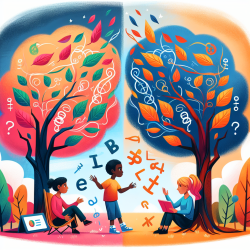The phonological development of bilingual children with Specific Language Impairment (SLI) is a complex area that requires nuanced understanding and targeted interventions. The research paper titled The Phonological Abilities of Bilingual Children with Specific Language Impairment: A Descriptive Analysis by Andrea A. N. MacLeod and Rebecca J. McCauley provides critical insights into this topic.
As a practitioner, leveraging the outcomes of this research can significantly enhance your ability to support bilingual children with SLI. Here are key takeaways and actionable steps based on the study's findings:
Understanding Phonological Development in Bilingual Children with SLI
The study compared five Canadian French-English bilingual children with SLI to four French monolingual children with SLI and four normally developing monolingual children. The phonological abilities of these groups were analyzed using both standard methods and recent measures proposed by Ingram and Ingram (2001; 2002).
Key Findings
- Delayed, Not Deviant Development: Bilingual children with SLI exhibited phonological abilities similar to younger, normally developing monolingual children, indicating a delay rather than a deviance in phonological development.
- Complexity in Word Attempts: Bilingual children with SLI attempted more complex words but had less accurate consonant production compared to their monolingual peers with SLI.
- Dialect Features: The acquisition of dialect features such as affrication in Canadian French was more advanced in monolingual children with SLI compared to their bilingual counterparts.
Actionable Steps for Practitioners
To implement these findings in your practice, consider the following strategies:
- Focus on Phonological Mean Length of Utterance: Utilize measures like phonological mean length of utterance to assess and track the complexity of words attempted by bilingual children with SLI. This can provide a more comprehensive understanding of their phonological abilities.
- Target Complex Word Production: Develop interventions that specifically target the production of complex words while also addressing consonant accuracy. This dual focus can help balance the phonological development of bilingual children with SLI.
- Monitor Dialect Feature Acquisition: Pay attention to the acquisition of dialect features in bilingual children with SLI. Tailor your interventions to support the mastery of these features, which can enhance overall language proficiency.
- Encourage Further Research: Advocate for more research on bilingual phonological development and SLI. Understanding the nuances of bilingualism can lead to more effective interventions and better outcomes for children with SLI.
By integrating these insights into your practice, you can better support the phonological development of bilingual children with SLI, helping them achieve their full potential.
To read the original research paper, please follow this link: The Phonological Abilities of Bilingual Children with Specific Language Impairment: A Descriptive Analysis.










